
T
ẠP CHÍ KHOA HỌC
TRƯ
ỜNG ĐẠI HỌC SƯ PHẠM TP HỒ CHÍ MINH
Tập 21, Số 9 (2024): 1660-1667
HO CHI MINH CITY UNIVERSITY OF EDUCATION
JOURNAL OF SCIENCE
Vol. 21, No. 9 (2024): 1660-1667
ISSN:
2734-9918
Websit
e: https://journal.hcmue.edu.vn https://doi.org/10.54607/hcmue.js.21.9.4185(2024)
1660
Research Article1
STUDYING MODIFICATION OF STICTIC ACID UNDER AlCl3
CATALYST IN DIMETHYLFORMAMIDE SOLVENT
Nguyen Tra Vuong Quang1, Nguyen Hong Nam Phuong1, Le Ho Minh Quang1,
Vo Tri Toan1, Nguyen Thi Truc Ngan2, Duong Thuc Huy1, Pham Duc Dung1*
1Ho Chi Minh City University of Education, Vietnam
2University of Science, Vietnam National University Ho Chi Minh City, Vietnam
*Corresponding author: Pham Duc Dung – Email: dungpd@hcmue.edu.vn
Received: March 26, 2024; Revised: April 02, 2024; Accepted: April 09, 2024
ABSTRACT
Stictic acid, a depsidone in many lichen species, is a potentially bioactive compound.
Derivatives of stictic acid were synthesised by halogenation or esterification. However, the effects of
these conditions on the decomposition of stictic acid have yet to be studied. Hence, the modification
of stictic acid was investigated using an AlCl3 catalyst and dimethylformamide solvent. The results
showed that approximately 20% of the stictic acid yield was transformed into other compounds in
these media. The decomposition of stictic acid is due to lactone ring-opening by the AlCl3 catalyst or
the dimethylamine produced by the reaction of AlCl3 and dimethylformamide.
Keywords: AlCl3; decomposition; dimethylformamide; lichen; stictic acid
1. Introduction
Lichens are an important source of bioactive compounds. Studies on the biological
activity of these compounds showed that depsidones isolated from lichen have antioxidant,
antibacterial, anti-inflammatory, antiviral and anti-cancer activity (Ranković et al., 2012;
Manojlović et al., 2012; Bhattarai et al., 2013; Khadhri et al., 2022; Wang et al., 2022). The
most typical depsidone of these compounds is stictic acid found in many lichen species such
as Usnea aciculifera, Parmotrema sp. (Parmotrema eliasaroanum…), Evernia prunastri,
Pseudevernia (Pseudevernia furacea…), Relicina (Relicina sydneyensis…), Xanthoparmelia
lusitam (Rankovíc, 2015). Stictic is a depsidone that consists of two phenolic components
linked together by an ether bond and an ester bond (Fig. 1 ) (Ismed et al., 2017).
Cite this article as: Nguyen Tra Vuong Quang, Nguyen Hong Nam Phuong, Le Ho Minh Quang, Vo Tri Toan,
Nguyen Thi Truc Ngan, Duong Thuc Huy, & Pham Duc Dung (2024). Studying modification of stictic acid under
AlCl3 catalyst in dimethylformamide solvent. Ho Chi Minh City University of Education Journal of Science,
21(9), 1660-1667.

HCMUE Journal of Science
Vol. 21, No. (2024): 1660-1667
1661
Figure 1. Structure of stictic acid
The stictic acid products can be modified by halogenation or esterification (Pham et
al., 2021; Huynh et al., 2018). The ester and ether bonds in the structure of stictic acid can
be affected during these transformations. However, very few studies have been conducted
on stictic acid derivative synthesis, and there has yet to be an investigation of the
decomposition of stictic acid in these reaction media. In this study, we investigated the effect
of AlCl3 and dimethylformamide (DMF) as a solvent in the structural modification of stictic
acid at high temperatures.
2. Experimental
2.1. General experimental procedure
NMR spectra were recorded on a Bruker Avance spectrometer (500 MHz for 1H-NMR
and 125 MHz for 13C-NMR) in DMSO-d6 and CDCl3. Thin-layer chromatography was
carried out on silica gel 60 (Merck, 40-63 μm), and spots were visualised by spraying with
a 10% H2SO4 solution, followed by heating. HRESIMS data were recorded on an LC-Agilent
1100 LC-MSD trap using a MicrOTOF-Q mass spectrometer.
2.2. Stictic acid modification procedure
AlCl3 (22 mg, 0.165 mmol) was added to a solution of stictic acid (1, 100.0 mg, 0.26
mmol) in acetic acid: DMF solvent (2.0 mL, 1:1, v/v). The mixture was stirred at 110 oC for
5 h. The reaction was periodically monitored using TLC. The resulting solution was
neutralised with saturated sodium hydrogen carbonate, then extracted with ethyl acetate-
water (1:1, v/v) to gain an organic layer. This layer was subsequently washed with brine
three times, then dried and applied to silica gel CC, eluted with hexane-chloroform-ethyl
acetate-acetone-acetic acid-water (50:125:250:250:1.5:1, v/v/v/v/v/v) to obtain 1a, 1b, 1c.
1a White amorphous powder; 1H NMR (CDCl3, 500 MHz) and 13C NMR (CDCl3, 125
MHz): see Table 1. HRESIMS found m/z 238.1052 (calcd. for [C12H15NO4+H]+, m/z
238.1001) .
1b White amorphous powder; 1H NMR (DMSO-d6, 500 MHz): see Table 1.
1c Yellow amorphous powder; 1H NMR (CDCl3, 500 MHz) and 13C NMR (CDCl3,
125 MHz): see Table 1.
3. Results and discussion
Stictic acid 1 was modified using an AlCl3 catalyst in DMF solvent. The results
showed that three compounds (1a, 1b and 1c) were isolated after 5h of reaction (Scheme 1).
O
O
CH
3
H
3
CO
CHO
CH
3
OH
O
O
O
HO
H

HCMUE Journal of Science
Nguyen Tra Vuong Quang et al.
1662
Scheme 1. Modification of stictic acid with AlCl3 and DMF
The 1H NMR spectrum of 1 exhibited the presence of two methyl groups [δH 2.51 (3H,
s, H-9) and 2.20 (3H, s, H-9’)], one methoxy group at δH 3.92 (3H, s, 4-OCH3), one aldehyde
proton at δH 10.44 (1H, s, H-8), two hydroxy groups [δH 8.21 (1H, br, 8’-OH) and 10.19 (1H,
s, 2’-OH)], and one aromatic proton at δH 7.10 (1H, s, H-5).
The 1H NMR spectrum of 1a resembled those of 1: an aromatic proton (δH 6.28, 1H,
s), an aldehyde proton (δH 10.27, 1H, s), and a methoxy group (δH 3.92, 3H, s) indicated the
presence of ring A of 1a. However, the absence of one methyl group at 8’-CH3 (δH 2.20, 3H,
s) and a hydroxy group at C-2’ (δH 10.19, 1H, s) indicated that ring B was absent in the
structure of 1a. In addition, the 13C NMR spectrum of 1a also showed a lack of signals on
ring B, two new methyl groups [(δH 2.51 (3H, s) and 2.50 (3H, s)] and a hydroxy group (δH
12.24, 1H, s) were observed. HMBC correlation of 1a showed that the two methyl groups
correlated with C-7 (δC 167.6), and the correlation between the two methyl groups indicated
that it was an amide group at C-1. The correlation of the hydroxy group (δH 12.24, 1H, s)
with C-1 defined the appearance of a hydroxy group at C-2 0(Fig. 2).
Table 1. NMR data of stictic acid and its transformation derivatives
No
1
1a
1b
1c
δH
(multi, J in
Hz)
(DMSO-d6,
500 MHz)
δC
(DMSO-
d6, 125
MHz)
δH
(multi, J in
Hz)
(CDCl3,
500MHz)
δC
(CDCl3,
125MHz)
δ
H
(multi, J
in Hz)
(DMSO-
d6,
500MHz)
δH
(multi, J in
Hz)
(CDCl3,
500MHz)
δC
(CDCl3,
125MHz)
1
-
113.0
-
118.6
-
-
123.4
2
-
161.9
-
159.7
-
-
156.7
3
-
114.7
-
108.8
-
-
113.6
4
-
162.9
-
162.2
-
-
159.0
5
7.10 (1H, s)
112.6
6.28 (1H, s)
103.3
7.13(1H, s)
-
118.8
O
O
CH
3
H
3
CO
CHO
CH
3
OH
O
O
O
HO
H
1
8
9
1'
5'
7'
8'
9'
3'
3
57
1
O
O
O
N
OH
1a
1
2
3
4
5
678
9
10
11 O
O
O
OH
N
1b
1
2
3
4
5
67
8
9
10
11
HO
O
O
O
N
O
O
O
N
OH
1c
1
35
7
8
9
10
11
5'1'
3'
7'
8'
9'
10'
11'
AlCl
3
/DMF
110
o
C

HCMUE Journal of Science
Vol. 21, No. (2024): 1660-1667
1663
6
-
151.1
-
147.4
-
-
145.0
7
-
166.5
-
167.6
-
-
166.4
8
10.44 (1H,
s)
186.4 3.16 (3H, s) 34.7
2.51 (3H,
s)
3.09 (3H, s) 34.6
9 2.51 (3H, s) 21.4 2.92 (3H, s) 37.8
2.50 (3H,
s)
2.83 (3H, s) 37.7
10 - - 10.27 (1H,
s) 193.7
10.28 (1H,
s)
10.26
(1H,s)
10.14 (1H, s) 193.9
11 - - 2.31 (3H, s) 20.8
2.28 (3H,
s)
2.27 (3H, s) 18.4
1'
-
109.0
-
-
-
-
123.4
2'
10.19 (1H,
s)
152.0 - - - - 156.7
3'
-
121.1
-
-
-
-
113.6
4'
-
148.1
-
-
-
-
159.0
5'
-
135.8
-
-
-
-
118.8
6'
-
137.6
-
-
-
-
145.0
7'
-
160.0
-
-
-
-
166.4
8'
6.61 (1H,
d)
8.21 (1H, d)
9.4 - - - 3.09 (3H, s) 34.6
9'
2.20 (3H, s)
95.2
-
-
-
2.83 (3H, s)
37.7
10'
-
-
-
-
-
10.14 (1H, s)
193.9
11'
-
-
-
-
-
2.27 (3H, s)
18.4
2-OH - -
12.24 (1H,
s)
- - 11.70 (1H, s) -
4-OCH3 3.92 (3H, s) 56.6 3.92 (3H, s) 56.0
3.93 (3H,
s)
3.92 (3H, s) 63.1
2'-OH
-
-
-
-
11.70 (1H, s)
-
4'-
OCH3
- - - - 3.92 (3H, s) 63.1
Figure 2. HMBC correlation of 1a
The 1H NMR spectrum of 1b showed signals identical to those of 1a. However, the
two methyl groups [δH 2.51(3H, s) and 2.50 (3H, s)] of 1b shifted to a higher frequency field
than the two methyl groups of 1a [δH 3.16 (3H, s) and 2.92 (3H, s)]. The lack of a hydroxy
group at C-2 of 1b indicated the presence of an amine group in the structure of 1b at C-2.

HCMUE Journal of Science
Nguyen Tra Vuong Quang et al.
1664
The 1H and 13C NMR spectra of 1c resemble those of 1a, except for the absence of a
proton at C-5. The HMBC spectrum of 1c also showed a correlation between the amide and
hydroxy groups at C-2, similar to the structure of 1a (Fig. 3). The absence of a proton at C-
5 is the key to deduce that the structure of compound 1a is linked at C-5.
Figure 3. HMBC correlation of 1c
Based on the products' formation, the proposed reaction mechanism is suggested to
involve two steps. The first step is the hydrolysis of DMF using an AlCl3 catalyst when
heated (Fig. 4). This resulted in the formation of dimethylamine and formic acid, reagents
for other transformations. Step two involves the formation of two products, 1a and 1b.
Dimethylamine produced from the hydrolysis of DMF attacked the ester group of stictic
acid, leading to the lactone ring opening. Then, water reacted at C-2 of ring A and ring B
was removed to synthesise 1a (Fig. 5). The mechanism of 1b preparation followed the
reversible order of 1a synthesis (Fig. 6). Water ring-opening of the lactone ring, followed by
the reaction of dimethylamine at C-2 of ring A, leads to the disconnection of ring B to
produce 1b. 1c was synthesised by the dimerisation of 1a using an AlCl3 catalyst (Sartori et
al., 1995) (Fig. 7).
Figure 4. Hydrolysis of DMF under AlCl3 catalyst
HO
O
CH3
O
H3C
O
N
H3C
CH3
O
O
O
N
OH
H
1
1
3
55'
3'
10 7'
8'
9'
10'
8
9
10
11
11'
ONAlCl
3
ON
Cl
3
Al
OH
2
ON
OH
2
Cl
3
Al
ONH
OH
Cl
3
Al
- AlCl
3
O
OH
H
N
H
+
t
o




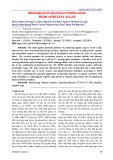
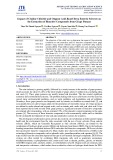
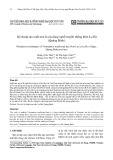
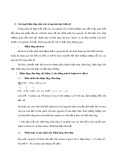
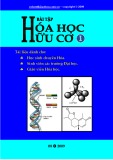
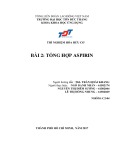

![Tài liệu Vi sinh vật môi trường [Mới nhất]](https://cdn.tailieu.vn/images/document/thumbnail/2025/20251123/ngkimxuyen/135x160/21891763953413.jpg)
![Sổ tay truyền thông Phân loại chất thải rắn sinh hoạt trên địa bàn tỉnh Quảng Nam [Chuẩn nhất]](https://cdn.tailieu.vn/images/document/thumbnail/2025/20251114/kimphuong1001/135x160/1701763094001.jpg)


![Quản lý chất thải nguy hại: Sổ tay Môi trường [Chuẩn nhất]](https://cdn.tailieu.vn/images/document/thumbnail/2025/20251029/kimphuong1001/135x160/9011761720170.jpg)









